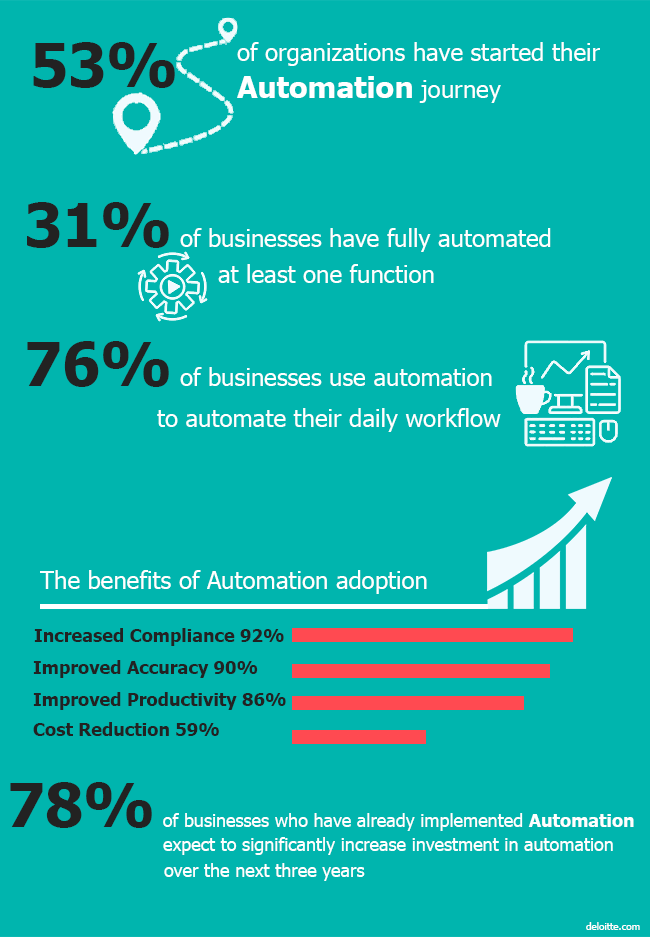
Document management is a cornerstone of success in today’s fast-paced business landscape. As organizations handle an increasing volume of information, the role of automation in document management has become indispensable. The back office plays a crucial role in supporting and administrating various aspects of the business. Forward-thinking business leaders worldwide recognize that enhancing customer-oriented systems and procedures is insufficient without an equally effective and integrated approach to automating back-office activities.
Workflow Automation enhances operational efficiency and unlocks valuable insights that can drive informed decision-making. McKinsey’s research has suggested that automation can reduce the cost of transactional tasks in the back office by 25% to 50%. These tasks include data entry, document processing, and other routine administrative activities. In this article, we delve into the transformative power of automation, exploring how it optimizes workflow processes, boosts efficiency, and provides actionable insights for businesses of all sizes.
The Importance of Automation in Back-Office Operations

Here, we’ve gathered a selection of automation statistics that we believe you should be aware of:
Benefits of Workflow Automation in Back-Office Operations
Traditional manual document-handling processes can lead to delays, errors, and inefficiencies. At Easy Data Access LLC, we firmly believe that streamlining document workflows through automation is not just a trend; it’s a strategic move toward optimizing back-office operations by simplifying document-centric tasks and processes. With our cutting-edge automation tools, you can transform cumbersome manual processes into seamless, efficient, and error-free workflows. Here’s a more detailed elaboration on the importance of workflow automation in the back office:
-
Automatic Data Capture for Accuracy
Automation and digitalization are intricately connected. Through the seamless integration of document scanning and automatic data capture into the Document Management system, businesses can profoundly transform their operations. This integration covers digitizing various documents, such as invoices, contracts, receipts, and correspondence. Our data capture solution, driven by automation, extracts organized data from these documents, thereby minimizing data entry errors and speeding up data processing. By converting documents into digital format and leveraging the precision of automated data extraction, organizations can attain elevated efficiency, enhanced accuracy, and expedited decision-making.”
-
Streamlining Operations for Efficiency
Efficiency stands as the cornerstone of successful back-office operations. It’s the driving force behind timely task completion, accurate data processing, and seamless communication. Document workflow automation is pivotal in achieving these goals by streamlining operations and eliminating manual, repetitive tasks. By automating tasks such as document routing, approval workflows, and notifications, organizations can eliminate bottlenecks and ensure that documents move seamlessly through various stages of processing. This accelerates task completion and enhances overall back-office efficiency, allowing employees to focus on higher-value activities.
-
Enhanced Accuracy and Reduced Errors
Manual document processes are prone to human errors, which can have far-reaching consequences for an organization. Document workflow automation incorporates predefined rules and validations that ensure data accuracy and consistency. Accuracy in document handling is particularly crucial in back-office functions such as financial transactions, regulatory compliance, and customer data management.
-
Accelerating Task Execution
Time is of the essence in today’s competitive business environment. Automated document workflows enable organizations to accelerate task execution by minimizing delays and reducing bottlenecks. Tasks are automatically routed to the appropriate individuals or teams, ensuring prompt action and efficient task handoffs. This is particularly valuable for multi-step processes that require multiple approvals or inputs. Automated alerts and notifications keep stakeholders informed about task progress, enabling quick interventions if necessary. As a result, back-office functions are performed with greater agility and responsiveness.
-
Enforcing Compliance and Mitigating Risks
Compliance with industry regulations and internal policies is critical to back-office operations, especially in highly regulated industries such as finance and healthcare. Document workflow automation enforces compliance by incorporating regulatory requirements into document processes. For instance, automated workflows can ensure that documents go through the necessary approval channels, that proper documentation is maintained, and that data privacy protocols are followed. This mitigates compliance risks and provides an audit trail for regulatory authorities.
-
Improved Collaboration and Communication
Effective communication and collaboration are key components of successful back-office operations. Automation tools facilitate seamless communication by providing a centralized platform for sharing information, assigning tasks, and collaborating on projects. Automated notifications and reminders inform team members about upcoming deadlines and pending actions. Collaboration is enhanced as team members can access real-time updates on task status, share documents, and provide feedback, regardless of their physical location. This promotes a culture of transparency and teamwork, leading to more cohesive and efficient back-office processes.
-
Data-Driven Insights and Decision-Making
In the age of data-driven decision-making, organizations rely on accurate and timely insights to make informed choices. Document workflow automation generates a wealth of data related to process performance, task completion times, and resource allocation. This data can be analyzed to identify trends, inefficiencies, and areas for improvement. Organizations can analyze process metrics, identify bottlenecks, and refine processes based on real-time data. These insights also facilitate process optimization, enabling organizations to fine-tune their document workflows for maximum efficiency and effectiveness.
-
Scalability and Adaptability
As businesses grow, the volume of documents and tasks in the back office can increase significantly. Manual processes may need help to keep up with the expanding workload. Workflow management solutions offer scalability, allowing organizations to handle higher volumes without compromising efficiency or accuracy. Automated Workflow processes can be easily adjusted or expanded to accommodate increased workloads, new tasks, or changes in organizational structure. This flexibility ensures that back-office functions remain efficient and effective despite evolving business requirements. Whether an organization experiences rapid growth or navigates through periods of change, workflow automation provides the foundation for agile and scalable operations.
-
Empowering Innovation and Strategic Focus
By liberating employees from routine tasks, workflow automation empowers them to focus on innovation and strategic initiatives. Back-office staff can dedicate their time and expertise to identifying new opportunities, developing innovative solutions, and driving business growth. With automation handling routine processes, employees can engage in high-value activities that contribute directly to the organization’s success and competitive advantage. This shift from task-driven to strategic-driven work fosters a culture of innovation and positions the organization for long-term success.
Workflow Automation Solutions for Every Department
Human Resources Automation
Human Resources is one of the most document-intensive departments in an organization. They not only have to face the challenge of document storage but also to streamline their everyday processes. The latest advancements in HR automation have facilitated the simplification and acceleration of HR processes.
- A positive outlook toward automation in the HR sector is held by 43% of HR professionals, who believe it has the potential to enhance the industry.
- The potential for saving approximately $5 trillion annually and reclaiming 69 working days exists through the automation of repetitive tasks, particularly administrative functions.
- 33% of enterprises look at document management software as a solution for paper document management and workflow automation.
With Docsvault as a Document Management and Workflow Automated solution, you can seamlessly digitize and oversee diverse HR workflow, including employee onboarding, leave requests, performance assessments, and more. Each step within your workflow is meticulously recorded, ensuring all information is safeguarded and readily retrievable for future use.
Finance Automation
Finance departments are often burdened with intricate tasks, including invoice processing, expense management, and financial reporting. These tasks are time-consuming and prone to errors that can have far-reaching consequences. However, with the advent of workflow automation, financial institutions are revolutionizing the way they operate.
A prime example of workflow automation’s impact on finance is the accounts payable process. Automating invoice processing can lead to faster approvals, reduced late payment penalties, and improved vendor relationships. With Docsvault’s AI-powered tools that include invoice scanning, automatic data capture, and Account Payable approval workflow process all under one digital roof, financial institutions can elevate their operational prowess and deliver more value to clients and stakeholders alike.
Key highlights of the approach include:
- Implementing Accounts Payable Automation can accelerate invoice processing times by 10%..
- MineralTree reports that automating invoice capture leads to a daily time saving of 1 hour.
- Adopting Accounts Payable Automation proves to be a self-rewarding investment, typically recouping its costs within 6 to 18 months.
Manufacturing Automation
The heart of automation in manufacturing industries lies in its ability to automate repetitive tasks, minimizing human intervention. Document Management with workflow automation significantly impacts various facets of manufacturing. For instance, it can expedite change order approvals, streamline compliance documentation for audits, and facilitate smoother communication between design, production, and distribution teams.
- McKinsey Instituteestimates that automating different tasks can raise productivity growth to 1.4% annually.
- According to a report, the world can save 749 billion working hours by automating 64 percent of manufacturing tasks.
Conclusion
Document Management with automated workflow has emerged as a game-changer for back-office operations. It transforms how organizations handle documents, streamlines processes, enhances accuracy, and drives efficiency. As businesses continue to navigate dynamic markets and evolving customer expectations, workflow automation provides the tools to achieve operational excellence, drive innovation, and remain competitive in a rapidly changing world. Using Docsvault, a document management software in the back office, is not just an option; it’s a strategic imperative for organizations looking to thrive in the digital age.